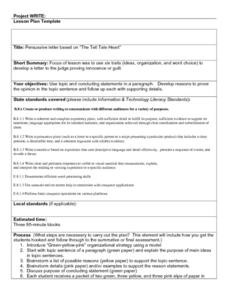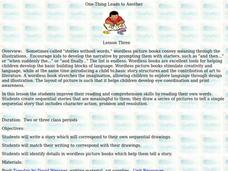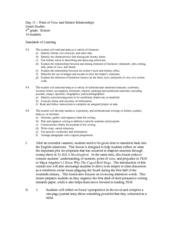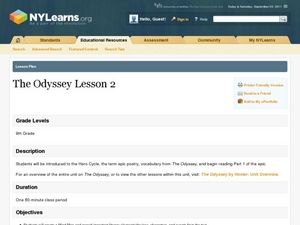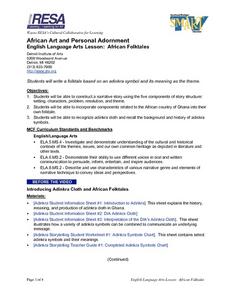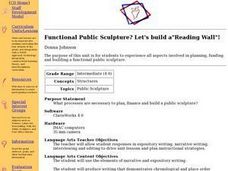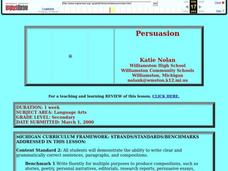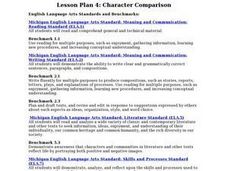Curated OER
Persuasive Letters and The Tell Tale Heart
Pupils write persuasive letters based on "The Tell Tale Heart." They brainstorm topic sentences, main ideas, and details. They analyze the character and determine if he is innocent or guilty. They create a map listing their reasons to...
Curated OER
Exploring Folk Traditions and Folk Beliefs
Ninth graders work together to brainstorm an idea to focus on the similiarties and differences between various cultures. Individually, they interview family members using questions they created based on their topic. They use their...
Curated OER
Harriet The Spy
Fourth graders investigate the style of diary writing as its own genre of literature. They read Harriet The Spy in order to have a text for this literature study. Students use the skill of prediction to preview the story, and then...
Curated OER
American Literature, The Earliest Days
Students prepare for and respond to literature selections. This package includes eleven lessons from the American Literature, The Earliest Days: Prehistory to 1750 each covering a different reading selection. Pre-reading and response...
Curated OER
Contrasting Cinderellas
Students compare and contrast the traditional Cinderella to the modern-day fairy tale, Cinder Edna. In this fairy tales lesson, students read both stories and construct a Venn diagram to compare the two fairy tales. Students identify how...
Curated OER
Rainforest Resources
Students explore products of the rainforest. In this environmental stewardship activity, students discover the resources that the rainforest holds and examine products from the rainforest used around the world.
Curated OER
Early Explorer Time-Line
Fourth graders study exploration of the New World. In this Exploration Age lesson, 4th graders research early explorers and create time lines that include picture, captions, and the routes of the explorers studied.
Curated OER
Acting Like a Bunch of Animals: Fables and Human
The video "The Tales of Aesop" traces for viewers the history of fables and identifies their characteristics. The class then goes to the web site "The Fisherman and the Little Fish" where they examine the classic and a modern version of...
Curated OER
Investigating Jack London's White Fang: Nature and Culture Detectives
Students explore images of the Klondike and read Jack London's White Fang to become culture and nature detectives. In this novel analysis lesson, students analyze the setting of the novel and the ways London portrays nature and culture....
Curated OER
One Thing Leads to Another
Students analyze the storytelling methods in wordless books. In this visual storytelling lesson plan, students write a story that correspond to a specific wordless picture book. Students create their own wordless picture book after...
Curated OER
Point of View and Mentor Relationships
Tenth graders analyze the role of mentors, point of view, and prejudice using the texts of To Kill a Mockingbird and Maya Angelou's I Know Why the Caged Bird Sings. For this literature analysis lesson, 10th graders review Scout's...
Curated OER
Poetics
In this online interactive philosophy worksheet, high schoolers respond to 10 short answer and essay questions about Poetics by Aristotle.
Curated OER
Southern Puritanism and Tennessee Williams
Students write an essay comparing Arthur Mille's The Crucible and one of Tennessee Williams' plays. In this Tennessee Williams lesson, students discuss the influence of Puritanism on modern American drama. Lesson includes a vocabulary...
Curated OER
The Odyssey Lesson 2
Ninth graders read and discuss part 1 of The Odyssey and create a mind map and visual images to represent vocabulary. In this reading lesson plan, 9th graders are introduced to poetry, and the Hero Cycle.
Curated OER
A Comparative Look at Migrations
Students explore and compare and contrast the migrations of African Americans in the United States in the decades before and after the Civil War.
Curated OER
Open Door, Closed Door Lesson Plan: Discrimination in Immigration And Migration
Students read The Northern Migration and research immigration policies of different nations for the past and the present. They create a bulletin board or spreadsheet using their information.
Curated OER
African Art and Personal Adornment: African Folktales
Students write a folktale based on an African adinkra symbol. They research its meaning and relate it as the theme.
Curated OER
Functional Public Sculpture? Let's build a"Reading Wall"!
Students interview a brick sculptor and aid in building a brick wall. They write expository paragraphs explaining the sequential process of building a reading wall. They create reading wall sketch designs. Students carve their names and...
Curated OER
Persuasion
Students explore the characteristics of a persuasive letter. They label each characteristic and they create a persuasive letter using the correct business letter format. Students recommend a school rule or change of a rule and justify...
Curated OER
Writing Letters Using Appleworks
Young scholars discover how to write letters using Appleworks. Following a demonstration by the teacher, they compose rough drafts of their letters. Working independently, students correct their drafts and type the final versions.
Curated OER
Character Comparison: Tales of a Fourth Grade Nothing
Fourth graders compare and contrast Fudge and Peter, two main characters from "Tales of a Fourth Grade Nothing". They use a software template to analyze and compare the characters in a rough draft, edit their work and then produce a...
Curated OER
Commercials
Young scholars observe as the teacher demonstrates how to use a digital video camera. They experiment with the camera to get to know its features. Finally they create a video commercial and edit it, inserting sounds, titles and other...
Curated OER
The Time I Got Lost
Third graders go through the writing process but substitute paper and pencil with the computer to create a story about "The Time I Got Lost".
Curated OER
People, Not Numbers: Bringing 12 Million into Personal Ter
Young scholars forge a compassionate link to the large numbers of people who were the victims of slavery as opposed to thinking of them simply in terms of numbers. They perform a math exercise to put the number of people in slavery into...


